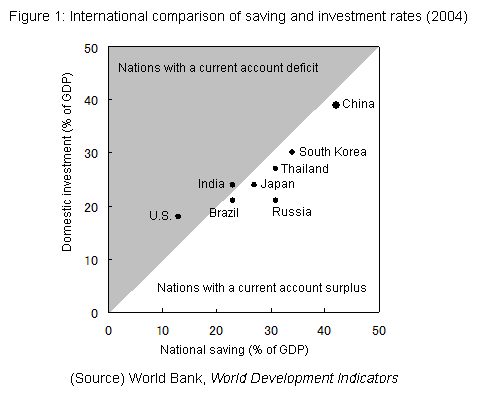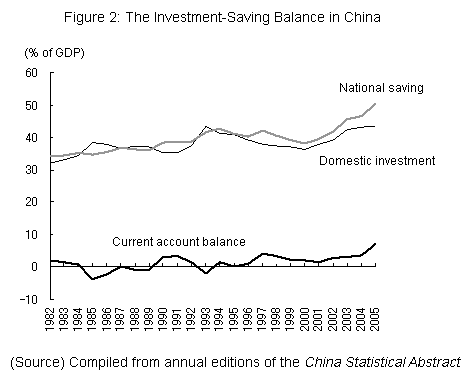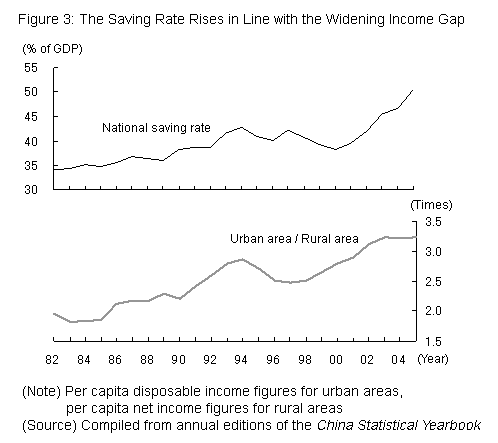In recent years, largely supported by investment on both the demand side and the supply side, the Chinese economy has been growing at an annual rate of some 10%. In fact, China's domestic investment to GDP ratio is not only high compared to other countries but also has been rising over time. This high investment level has been made possible by the fact that the ratio of national saving, the most important source of investment funding, to GDP has attained very high levels both internationally and historically (figure 1). Factors behind the high saving rate include a comparatively young population, better-than-expected growth, a widening income gap, constraints on consumption due to an underdeveloped financial system, an underdeveloped social security system, and high saving by the corporate sector amid high profits. However, considering that these factors are expected to turn around in the future, China's saving rate will likely decline.
China's high saving rate and the factors behind it
National saving is the sum of domestic investment and current account balance. Furthermore, if each variable is divided by GDP, we can calculate the national saving rate. China's national saving rate has been rising from around 35% during the early stages of market-opening reforms in the 1980s to 50.5% in 2005 (figure 2). Most of the national saving is used for domestic investment (43.4% of GDP in 2005), but what exceeds that shows up as a current account surplus (7.1% of GDP in 2005). In this way, the rising saving rate is widening China's external imbalance, which in turn leads to trade frictions and upward pressure on the yuan.


The high rate of saving in China can be explained as follows:
(1) The life cycle hypothesis
People generally save to prepare for old age. Reflecting this, the saving rate rises from one's youth to middle age, and declines in old age. Therefore, a society's demographic composition is an important factor that determines its saving rate. If we are to follow this life cycle theory, the high rate of saving in Chinese households reflects the fact that the country has a high percentage of working-age population, and this figure has been rising.
(2) The permanent income hypothesis
When income is divided into permanent income and transitory income, the propensity to consume increases when the permanent income ratio is high, while the propensity to save increases when the transitory income ratio is high. China has continued to see growth of 10%, but since growth is expected to slacken in coming years, the current increase in income is viewed as transitory income, and is thus channeled toward savings.
(3) The income gap hypothesis
The income gap is large in China, and it is widening. Generally speaking, the saving rate of high-income earners is high, while that of low-income earners is low. Because the saving rate of the household sector is the weighted average of the two, the more imbalanced the income distribution, the greater the weight of high-income earners. In fact, the overall saving rate in China has been rising in line with the growing income gap between urban and rural areas (figure 3).

(4) The underdeveloped financial system hypothesis
Because consumer finance, such as installment plans and credit cards, is well-developed in industrialized countries, people can cover their consumption with debts by putting up their future earnings as collateral. In contrast, because the financial system is still underdeveloped, consumers are faced with more severe liquidity constraints.
(5) The underdeveloped social security hypothesis
Most developed countries have substantial social security measures such as unemployment insurance, medical insurance, and pensions, and their citizens do not need to increase their savings. In China during the planned economy era, such roles, albeit insufficiently, had been played by people's communes in rural areas and state-owned enterprises in urban areas. However, as the transition from a planned economy to a market economy progressed, the communes were disbanded and more and more state-owned enterprises have been privatized, and even the companies that have remained in state hands have come to focus on their business activities. In the absence of a new, properly functioning social security system, people have no choice but to strive to save money.
(6) The high corporate saving hypothesis
The rise in the saving rate in China can be seen not only in the household sector but also in the corporate sector. Estimates based on flow of funds tables show that from 2000 to 2005, savings vis-a-vis GDP in the household and corporate sectors rose from 14.8% to 16.2% and 15.5% to 20.4%, respectively (Kuijs, 2006). In recent years, corporate sector earnings have improved tremendously, especially in the state-owned enterprises that have a strong monopoly in their markets. These enterprises are not obliged to pay dividends to the government, and so the abundance of their internal reserves become the saving of the corporate sector and pay for new investment. Of course, in this case, wasteful investment is aggravated because the cost of raising funds is effectively zero.
These hypotheses should be understood as being more complementary to rather than contradicting each other.
The expected decline in China's saving rate
However, these factors that are leading to a high saving rate in China will probably undergo major changes in the coming years, and the saving rate is likely to correspondingly decline in the medium to long term.
First, in the form of paying the price for the one child policy, the percentage of the working-age population will start falling from 2010, and China will become a full-fledged graying society.
Second, as society ages, rural areas will be drained of surplus labor, and as the nation's stage of development approaches that of developed countries, the advantage of being a latecomer in the process of economic development will fade away, leading to a decline in economic growth.
Third, correcting the income imbalance is a prerequisite for the Chinese government to maintain social and political stability and to achieve its goal of establishing a "harmonious society."
Fourth, as symbolized by the overseas listing of major state-owned banks, financial reforms are proceeding at a rapid pace, and the liquidity constraints faced by consumers are likely to be gradually eased.
Fifth, while there are many issues to be resolved, the creation of social security systems such as pensions is progressing.
Lastly, public opinion is on the rise for state-owned enterprises to pay dividends to the state, which is providing capital for them, and return their profits to the citizens. Specific measures for this are currently being debated within the government.
Thus, the current high saving rate will be difficult to maintain, and China will have to swiftly shift from conventional "extensive" growth based on the expansion of input to "intensive" growth brought about by increases in productivity in order to sustain high growth.


